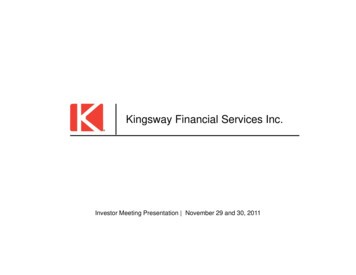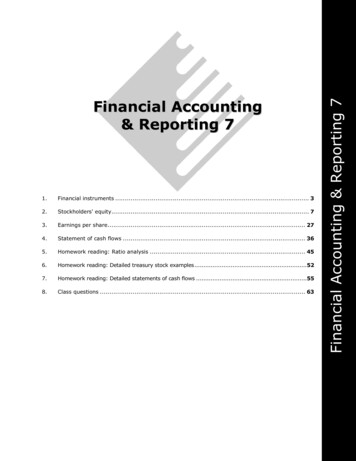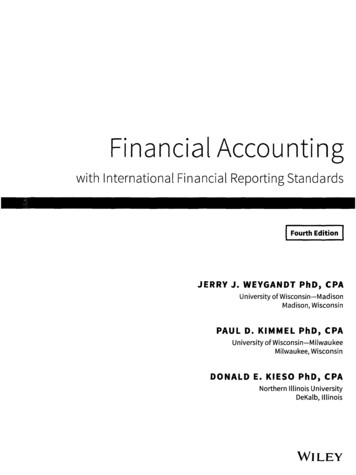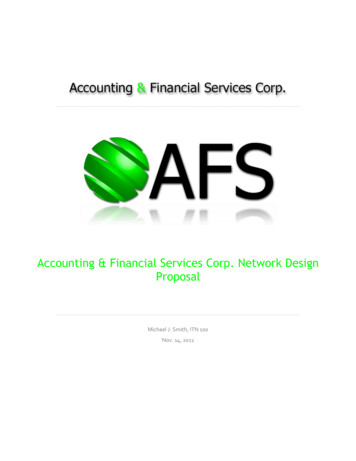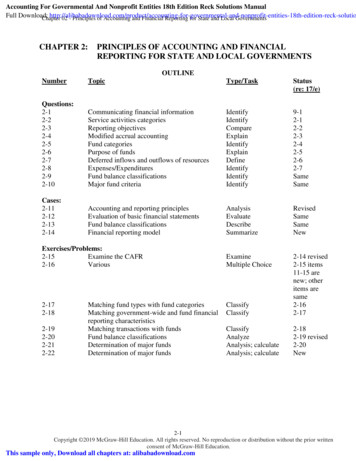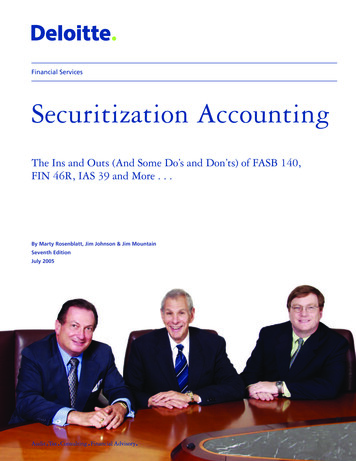
Transcription
Financial ServicesSecuritization AccountingThe Ins and Outs (And Some Do’s and Don’ts) of FASB 140,FIN 46R, IAS 39 and More . . .By Marty Rosenblatt, Jim Johnson & Jim MountainSeventh EditionJuly 2005
Key Parties to a Hypothetical Term Securitization ervicer/SellerWholly Owned BankruptcyWholly Owned BankruptcyRemote Special-PurposeRemote Special-PurposeCorporation (Depositor)Corporation (Depositor)Owner Trustee BankSwap CounterpartyQSPE Trust IssuerIndenture Trustee BankClass A-1NotesClass A-2 NotesClass A-3 Notes andClass A-4 NotesBeneficial InterestHoldersTrustCertificatesretained byTransferor or anAffiliate (BeneficialInterest Holder)Summary of Monthly Activity*Servicing FeesReimbursementsof ServicerAdvancesServicer Advancesto CoverDelinquent LoansPrincipal & Intereston ReceivablesNoteholdersPayments onCertificatesInterest & PrincipalTrustResidualCertificateHolder(s)Fixed Swap PaymentsPaymentsFloating SwapWithdrawals fromReserveAccountDepositsto Reserve AccountObligors onReceivablesSwap CounterpartyReserve AccountExcessFundsPayments on ReceivablesServicerSeller* These charts provide only a simplified overview of the relationships between the key parties to the transaction and the monthly flow of funds. The inspiration for thesecharts was found in the prospectus for GMAC’s Capital Auto Receivables Asset Trust 2004-1 deal.On the Cover (left to right):Marty Rosenblatt is the founding partner of Deloitte & Touche LLP’s securitization practice and an Executive Vice President of theAmerican Securitization Forum.Jim Johnson is a partner in the National Office of Deloitte & Touche LLP and is the Firm’s representative on the FASB’s EmergingIssues Task Force.Jim Mountain is a partner in the New York Office of Deloitte & Touche LLP and serves as the Professional Practice Director for theFirm’s securitization practice.
Table of ContentsIntroductionChapter 1Chapter 2What’s New in 2005? Is Off-Balance Sheet Treatment Still VIE-able?What Is FASB 140 and When Does It Apply?Determining Whether a Securitization Meets the Sale CriteriaWhen is a securitization accounted as a sale?What if I fail to comply with the sale criteria?Who is considered to be the transferor in a “rent-a-shelf” transaction?Do I ever have to consolidate a QSPE? How about an SPE?What does it take to be a QSPE?If you don’t put it to me, can I call it from you?Can I have my cake and eat it too with debt-for-tax and a sale for GAAP?Can warehouse funding arrangements be off-balance sheet?Can I metaphysically convert loans to securities on my balance sheet?Desecuritizations - What if we put Humpty Dumpty back together again?Do banks have to isolate their assets in a two-step structure to get sale treatment?Do I always need to bother my lawyer for an opinion letter?Can I structure my securitizations to avoid gain on sale accounting?Chapter 3Determining Gain or Loss on SaleHow do I calculate gain or loss when I retain some bond classes or residual?How is gain or loss calculated in a revolving structure?Is there a sample gain on sale worksheet that I can use as a template?Is fair value in the eye of the “B-Holder”?What are the auditors’ responsibilities for fair value?What if I can’t estimate fair value?Do I record a liability for retained credit risk, or is it part of the retainedbeneficial interest in the asset?When do I record an asset for servicing?How are cash reserve accounts handled? What is the “cash-out” method?How are prefunding accounts handled?Chapter 4Are There Any Highlights of FIN 46 (R) – Consolidation of Variable Interest Entities?Chapter 5Investor Accounting IssuesHow do I account for plain-vanilla MBS and ABS?How do I account for securities with prepayment and/or credit risk?Chapter 6Through the Looking Glass, FASB 140’s Required DisclosuresChapter 7Can Banks Get Regulatory Capital Relief Through Securitization?Chapter 8Do the Statutory Accounting Principles for Insurance Companies Embrace FASB 140?Chapter 9International Securitization AccountingIAS 39CanadaJapanChapter 10The SEC’s New Minimum ABS Servicing Criteria and Compliance Reporting RegimeChapter 11Are You Ready to Play “Who Wants to be an Accountant?”Chapter 12What to Expect in 2006 - FASB 140 (R)QSPEs and isolation of financial assetsHybrid financial instrumentsServicing rightsExcerpt from SEC’s June 2005 Report and Recommendations Pursuant to Section 401(c)of the Sarbanes-Oxley Act of 2002 on Arrangements with Off-Balance SheetImplications, Special Purpose Entities, and Transparency of Filings by IssuersAppendixQSPE Qualifications ChecklistCrossword 39404344454949535660646565727274798282838384iviix
4What’s New in 2005? Is Off-BalanceSheet Treatment Still VIE-able?This booklet deals with securitizations, mainly those employing term structures and traditional asset types. We made no attemptto deal with the other transaction types covered in FASB 140 - repos, dollar rolls, securities lending, wash sales, loan syndications,loan participations, banker’s acceptances, factoring arrangements, debt extinguishments and in-substance defeasances. Thispotpourri of transactions found in FASB 140 explains why many securitization marketplace participants find it cumbersome towork with the actual statement. (We hope you have a better experience with this booklet!) The other advantage of this bookletis that reference material for all the relevant, but separate, guidance issued by FASB, the EITF, the SEC, the AICPA and the IASB isassembled in one place.We expect that this booklet will have a shelf life of less than one year. As we go to press, the FASB is considering various significantamendments to FASB 140. If they stick to their timetable, the amendments will go into effect in 2006. See discussion of possibleamendments in Chapter 12 (page 82), “What to expect in 2006 - FASB 140 (R).”After reading this booklet, you might be convinced that a fundamental disconnect exists among law, economics, bank regulation,tax law, ERISA, the ‘40 Act and accounting when it comes to securitization. You, like us, might not think that FASB 140 is a perfectsolution. But, by nature, no accounting standard is ever perfect for all financial statement preparers and users. Yet, we find FASB 140suitable guidance for most securitization transactions.The FASB and its Emerging Issues Task Force still face the challenge of keeping pace with the continuous innovations in thesecuritization market and developing additional guidance. This is the seventh edition in this series of booklets. Since our last edition,the FASB has created a new framework for analyzing special-purpose vehicles. While keeping FASB 140’s QSPEs, they added a newuniverse of variable interests, expected losses and primary beneficiaries. The new standard, FIN 46, was initially released in January2003 and was a bit rough around the edges. By December 2003, the FASB came out with substantial improvements in a revisedversion, FIN 46R. But even with the improvements, securitizers and their auditors struggle with the new concepts and unfamiliarjudgments now required.The staff of the Securities and Exchange Commission also continues to be keenly interested in structured finance transactions,including securitizations, and regularly questions registrants about their accounting for and disclosure of even seemingly straightforward deals. The staff expects securitizers to make clear and full financial statement disclosure of their structured transactions.The disclosure should identify key features that drive accounting determinations one way or the other and allow readers to grasp theeconomic significance of those features. See page 84 for excerpts from the SEC’s Off-Balance Sheet Study Report to Congress forfurther information.In this ever-changing marketplace, we make a constant effort to stay current and hope that this effort is reflected in the followingpages. We recommend that readers seek up-to-date information and advice regarding the application of accounting standardsto the particular circumstances involved in any specific transaction. Thank you for your continued interest. We look forward toproviding further updates in the months and years ahead.ChapterSincerely,If you would like to receive our periodic bulletin, S.O.S.-Speaking of Securitization, covering accounting, tax, regulatory and otherdevelopments affecting the securitization market, just send an email to securitization@deloitte.com.
What Is FASB 140 andWhen Does It Apply?FASB 1401 applies to: Public and private companies Public and private offerings All transfers of financial assets Resecuritizations of existing ABS, MBS, CMBS andCDO classes Net interest margin (NIM) transactionsWhat is FASB 140 and when does it apply?Chapter 1the IASB may result in completely different accounting treatmentfor securitizations than transactions accounted for under FASB140. Both the FASB and the IASB are actively working to alignU.S. and international accounting standards in many areas.When it comes to securitizations however, that convergence willlikely be several years in coming. See “IAS 39” in Chapter 9,beginning on page 65.FASB 140 does not apply to: Transfers of nonfinancial assets (or unrecognized financialassets) such as operating lease rents, unguaranteed leaseresiduals from capital leases, servicing rights, stranded utilitycosts, or sales of future revenues such as entertainers’ royaltyreceipts or synthetic structures based on reference pools Most investor accounting (but, see Chapter 5, “InvestorAccounting Issues” beginning on page 49) Income tax sale vs. borrowing characterizations or tax gain/loss calculations Risk-based capital rules for depository institutions2 Statutory accounting or risk-based capital rules forinsurance companies3 Accounting principles outside of the United States - but FASB140 does apply to foreign companies that follow U.S. GAAP(e.g., for SEC filings) and transactions by foreign subsidiariesin consolidated financial statements of U.S. parentsThe International Accounting Standards Board (IASB) hasissued guidance on accounting for securitizations in the revisedInternational Accounting Standard 39 Financial Instruments:Recognition and Measurement (IAS 39). Guidance provided by1 FASB Statement 140: “Accounting for Transfers and Servicing of Financial Assets and Extinguishments of Liabilities, a replacement of FASB Statement 125 (September 2000)”2 Federally chartered banks and thrifts are required to follow generally accepted accounting principles (i.e., FASB 140) when preparing Call Reports and Thrift FinancialReports. However, pursuant to the risk-based capital rules, in asset sales in which the bank provides recourse, the bank generally must hold capital applicable to the fulloutstanding amount of the assets transferred subject to a “low-level exposure” rule. The federal banking agencies require dollar-for-dollar capital for all retained intereststhat provide credit enhancement and limit the maximum amount of credit-enhancing interest-only strips a bank may hold as a percentage of Tier 1 capital. See “CanBanks Get Regulatory Capital Relief Through Securitization?” on page 60.3 The National Association of Insurance Commissioners (NAIC) has adopted securitization accounting guidance for statutory reporting purposes in Statement of StatutoryAccounting Principles No. 91, Accounting for Transfers and Servicing of Financial Assets and Extinguishment of Liabilities. See Chapter 8 (page 64) “Do the StatutoryAccounting Principles for Insurance Companies Embrace FASB 140?”5
6Chapter 2Determining Whether aSecuritization Meets the Sale CriteriaChapter2When is a securitization accounted as a sale?Sale CriteriaPeople often describe a securitization as being either a sale ora financing. Actually, a securitization might be accounted for inone of the following five ways, depending on the deal structureand terms: As a sale (for example, when the transferor has nocontinuing involvement with the transferred assets). As a financing (when the transfer fails to meet one or moreof FASB 140’s criteria for sale accounting discussed below). As neither a sale nor a financing (when no proceeds arereceived other than interests in the transferred assets, as intransferring additional assets to a credit card master trust ora swap of mortgage loans for mortgage-backed securities). As a partial sale (when the transferor retains servicing and/orone or more of the bond classes and the FASB 140 salecriteria are met for the sold classes). This is probably themost prevalent treatment of securitizations today. The cashfunding is “off-balance sheet” and the retained interestscontinue to be on-balance sheet assets of the transferor,albeit assets of a different kind. Partial sale is also sometimesused to describe transactions in which only a partial interest(e.g., a pro rata nine-tenths interest in loans) is securitized. As a part sale, part financing (when the sale of certainclasses meet the FASB 140 sale criteria while the “sale” ofother classes do not, such as when the transferor holds a calloption on a particular class).A securitization of a financial asset, a portion of a financial asset,or a pool of financial assets in which the transferor (1) surrenderscontrol over the assets transferred and (2) receives cash or otherproceeds is accounted for as a sale (or partial sale). Merelyreceiving what FASB 140 calls “beneficial interests”4 in the sameunderlying assets does not count as proceeds for this purpose.Control is considered to be surrendered in a securitization only ifall three of the following conditions are met: (a) the assets havebeen legally isolated; (b) the transferee has the ability to pledgeor exchange the assets; and (c) the transferor otherwise nolonger maintains effective control over the assets. Each of theserequirements is discussed further below:a. Legal Isolation - The transferred assets have been isolated- put beyond the reach of the transferor, or any consolidatedaffiliate of the transferor, and their creditors (either by asingle transaction or a series of transactions taken as awhole) - even in the event of bankruptcy or receivership ofthe transferor or any consolidated affiliate. [9a and 27]5This is a “facts and circumstances” determination, whichincludes judgments about the kind of bankruptcy or otherreceivership into which a transferor or affiliate might be placed,whether a transfer would likely be deemed a true sale at law,and whether the transferor is affiliated with the transferee. Incontrast to the “going-concern” convention in accounting, thetransferor must address the possibility of bankruptcy, regardlessof how remote insolvency may appear given the transferor’scredit standing at the time of securitization. Even a AA-ratedissuer of auto paper must take steps to isolate its assets. It is notenough for the transferor merely to assert that it is unthinkablethat a bankruptcy situation could develop during the relativelyshort term of the securitization. The securitization markethas witnessed several unexpected bankruptcies of formerlyinvestment-grade companies through the years.4 Beneficial interests are typically issued either in the form of notes or bonds representing pay-through obligations of a securitization vehicle collateralized by thetransferred assets and governed by an indenture, or certificates representing pass-through ownership of interests in the transferred assets and governed by a poolingand servicing agreement.5 Numbers within brackets represent paragraph references in FASB 140, unless otherwise indicated.
STEP 2: The SPC transfers the assets to a trust or otherlegal vehicle with a sufficient increase in the credit andyield protection on the second transfer (provided by asubordinated retained beneficial interest or other means) tomerit the high credit rating sought by investors.The second transfer may or may not be judged a true sale at lawand, in theory, could be reached by a bankruptcy trustee for theSPC. However, the first SPC’s charter forbids it from undertakingany other business or incurring any liabilities, thus removingconcern about its bankruptcy risk. The charter of each SPCmust also require that the company be maintained as a separateconcern from the parent to avoid the risk that the assets of theSPC would be “substantively consolidated” with the parent’sassets in a bankruptcy proceeding involving the parent. [83]See page 26 and following for the forms of lawyer’s lettersneeded to provide reasonable assurance that the transferredassets would be “beyond the reach of creditors.”b. Ability of Transferee to Pledge or Exchange theTransferred Assets - The transferee (or, in a two-stepstructure, the second transferee) is a qualifying specialpurpose entity (QSPE) and each holder of its beneficialinterests has the right to pledge, or the right to exchange,its beneficial interests. If the issuing vehicle is NOT a QSPE,then sale accounting is only permitted if the issuing vehicleitself has the right to pledge or the right to exchange thetransferred assets. [9b and 29]If the transferor receives cash in return for the assets transferredto a non-QSPE and has no continuing involvement of any kind,(no servicing responsibilities, no participation in future cash flows,no recourse obligations other than standard representationsand warranties) the transfer should be accounted for as a saleeven though, as in most securitizations, the transferee maybe substantially constrained from pledging or exchanging thetransferred asset. To fail 9b the transferor must receive more thana trivial benefit as a result of the constraint. [FASB Special Report:Questions and Answers - Guide to Implementation of Statement140 (FASB 140 Q & A), Question 22A]Determining Whether a Securitization Meets the Sale CriteriaSecuritizations generally use two transfers to isolate transferredassets beyond the reach of the transferor and its creditors:STEP 1: The seller/company transfers assets to a specialpurpose corporation (SPC) that, although wholly owned,is designed in such a way that the possibility that thetransferor or its creditors could reclaim the assets is remote.This first transfer is designed to be judged a true sale at law,in part because it does not provide “excessive” credit oryield protection to the SPC.Whether or not a securitization vehicle is a QSPE is extremelyimportant because a transferor does not consolidate the assetsand liabilities of a QSPE. QSPEs must be designed to operatewith limited decision-making authority. A non-qualifying vehiclemay need to be consolidated. See Chapter 4 (page 45) ”AreThere Any Highlights of FIN 46 (R) - Consolidation of VariableInterest Entities?”Note that in a two-step structure (see above), the entity thatissues the securities (e.g., the trust) needs to be the QSPE.The “intermediate SPC” (e.g., the Depositor) is typically notconsidered a QSPE. As long as the “issuing SPE” is a QSPE, thenature of the intermediate entities should not affect consolidationaccounting. This is also true with respect to “rent-a-shelf”transactions. FASB 140 does not address the balance sheet orincome statement accounting by the SPC, which is usually theregistrant for SEC filing purposes, or the related trusts that areusually the issuers. Financial statements for these special-purposecorporations are usually not required or requested.Any restrictions or constraints on the transferee’s rights tomonetize the cash inflows (the primary economic benefits offinancial assets) by pledging or selling those assets have tobe carefully evaluated to determine whether the restrictionprecludes sale accounting, particularly if the restriction providesmore than a trivial benefit to the transferor, which, according toFASB 140, is a rebuttable presumption. [31]7
8Holders of a QSPE’s securities are sometimes limited in theirability to transfer their interests, due to a requirement thatpermits transfers only if the transfer is exempt fro
Crossword Puzzle vi Index ix. 4 Chapter What’s New in 2005? Is Off-Balance Sheet Treatment Still VIE-able? If you would like to receive our periodic bulletin, S.O.S.-Speaking of Securitization, covering accounting, tax, regulato




